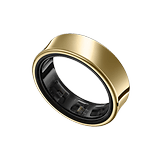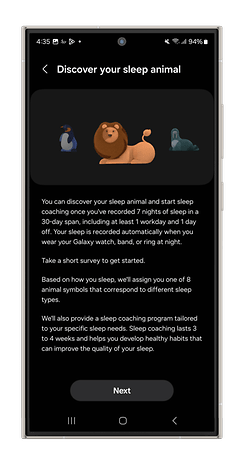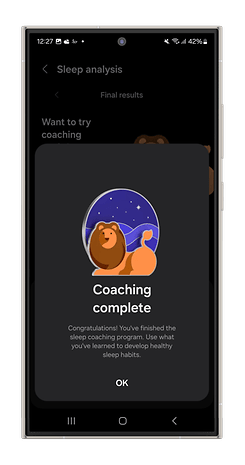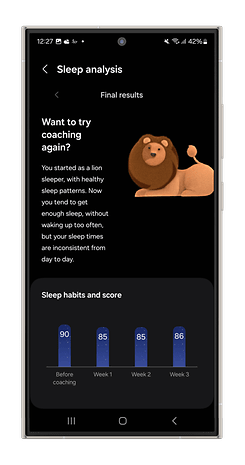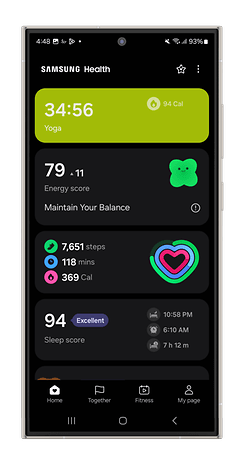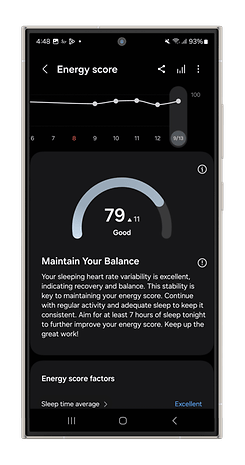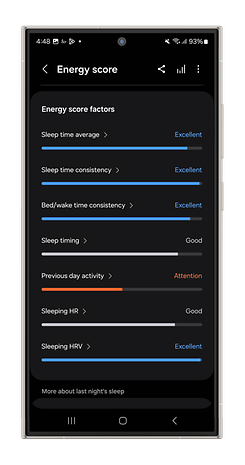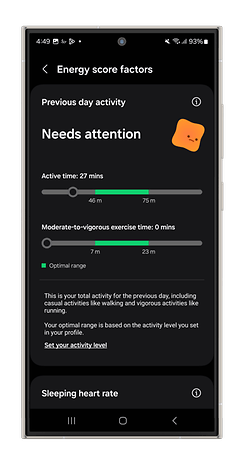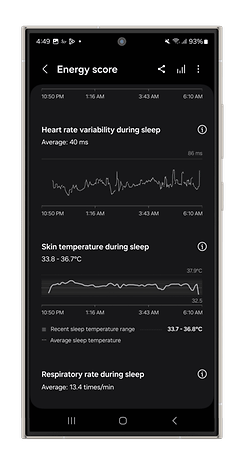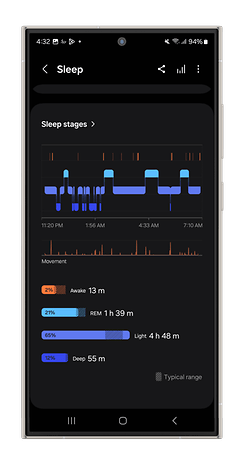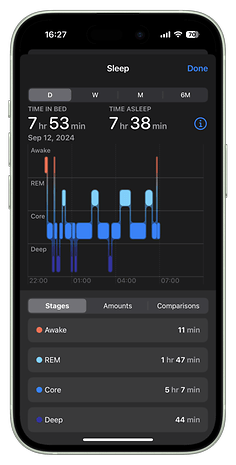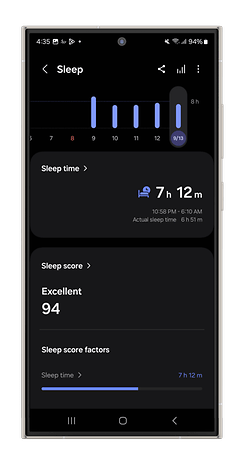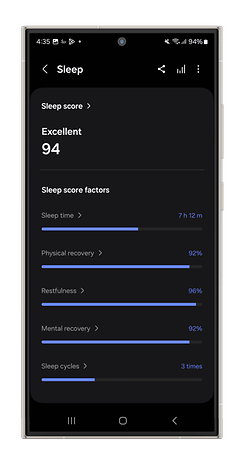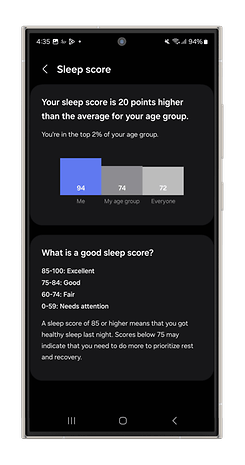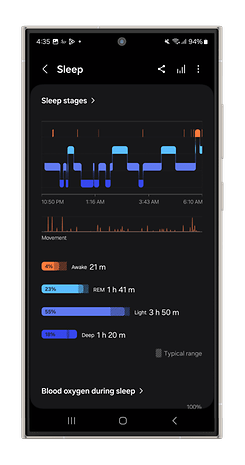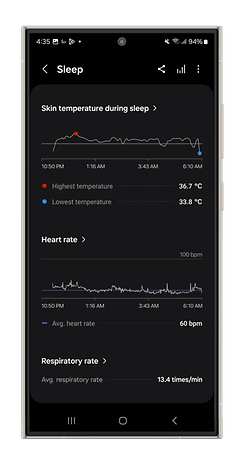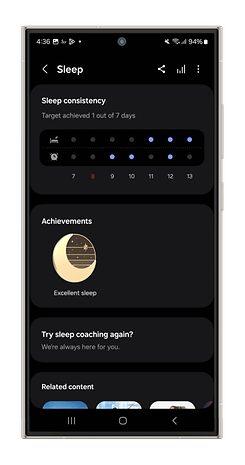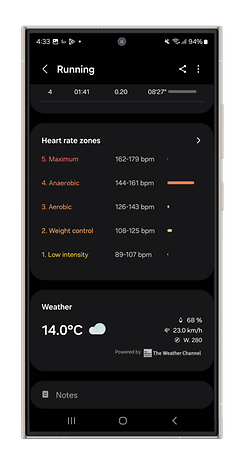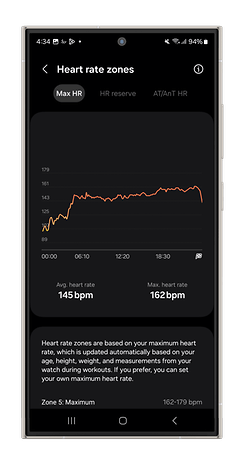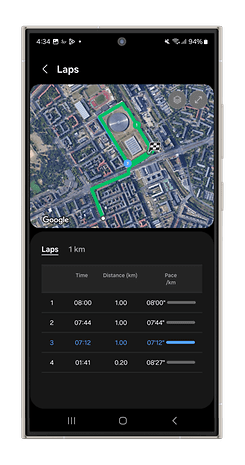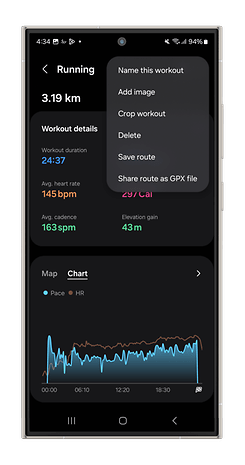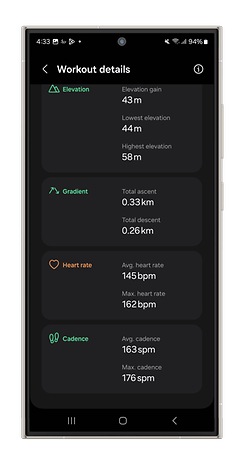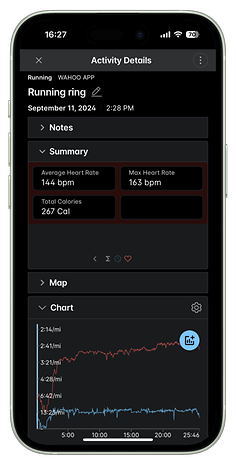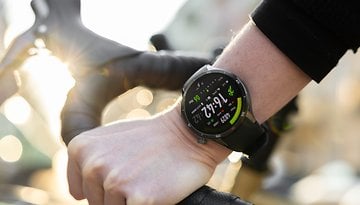Galaxy Ring: Reliable Tracking, When the Software Keeps Up
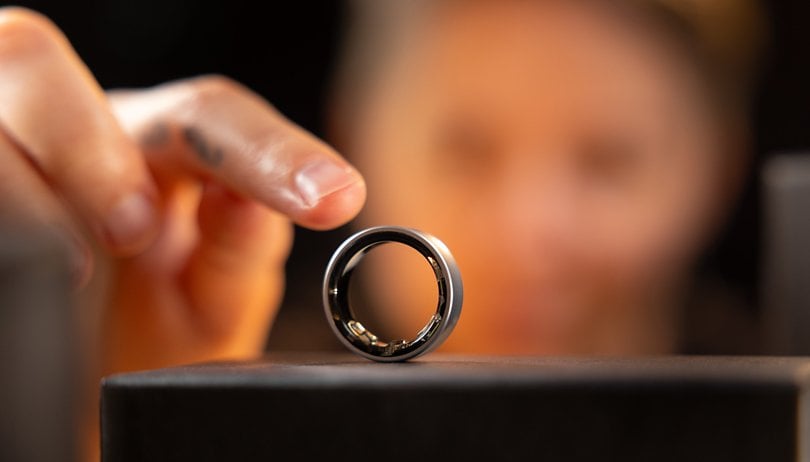

I’m sticking to my stance on smart rings: They’re not really fitness devices, but more geared towards health monitoring. Sure, fitness plays a big role in overall health, but there’s a distinction. And this is where Samsung had a real shot at bridging the gap—but they missed it. The Galaxy Ring? Solid build quality, no doubt. But what about its health and fitness features? Let's take a look at the data and see what it shows us.
Good
- Premium build quality
- No subscription required
- Up to 5-day battery life
- Convenient charging case
Bad
- Not really designed with fitness tracking in mind
- Some features are locked into Samsung's ecosystem
- Pricey
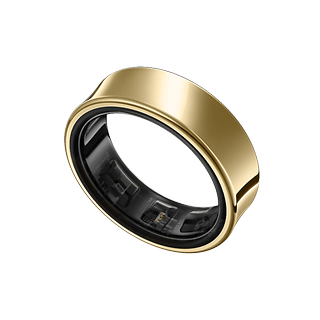
In a nutshell
I'm not going to sugarcoat it—this is only the third smart ring I've tested, and no, I didn’t get my hands on the Oura Ring, the current gold standard in this space. That said, we’re talking sensors and metrics here, and after years of reviewing everything from smartwatches to smartphones, I’ve got a pretty good grasp on how this tech should work.
If there’s one company that could shake up the wearable game with a fresh take on form factors, it’s Samsung. I’ve been testing the Galaxy Ring for a while, and just four days ago, a One UI update dropped on the Galaxy S24 Ultra—massively improving the overall experience. Sure, you’ll find plenty of reviews online calling the Ring inaccurate, but here’s the kicker: the latest update fixed a lot of those issues.
- Best Samsung smartwatches: What is the right Galaxy Watch for you?
However, I went into this with high expectations. I tested the Samsung Galaxy Watch Ultra alongside the Galaxy Ring, and honestly, Samsung's method for using algorithms to combine data is still a bit unclear. To give it a fair shake, I split my time: half with the ring connected to the smartwatch and the other half using it standalone.
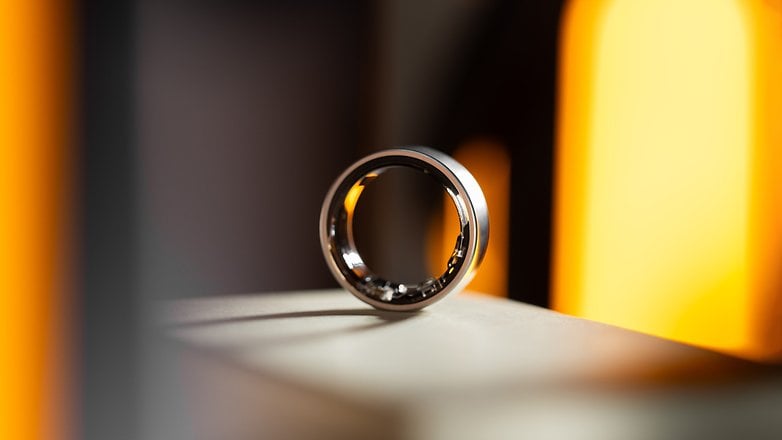
Price & Availability
When it comes to hardware, the Galaxy Ring brings a sleek, minimalist design to the table and comes in three color options: Silver, Black, and Gold. It’s packed with features like advanced sleep tracking, continuous heart rate monitoring, skin temperature measurement, and a range of fitness functions.
And, depending on the size you go for, you’re looking at up to 7 days of battery life, which isn’t bad at all for a ring. But here’s the kicker—the Galaxy Ring is priced at $399 in the US, which definitely puts it in premium territory.
That said, unlike the market leader Oura, there’s no subscription fee tied to the Galaxy Ring. But honestly, that’s not a huge selling point these days—Amazfit, Ultrahuman, and RingConn are all subscription-free rings too, so Samsung's just keeping up with the competition on that front.
So here’s the big question: does the Galaxy Ring truly earn its place among the best smart rings of 2024? It’s time to lay out all of Samsung’s cards and see how it stacks up.
Compact & Comfortable
I wore the ring for pretty much everything, only taking it off when washing dishes or my hands. So, naturally, I expected to see some scratches—but after almost a month of use, the Titanium cover is still scratch-free. That’s impressive. On top of that, the Galaxy Ring is compact, lightweight, and super comfortable to wear on the index finger, which is where it’s designed to sit .
Like any smart ring on the market, the Galaxy Ring comes with its own design quirks, such as a distinct concave shape. Samsung has even added a subtle notch at the bottom to help users get the placement just right.
Pros:
- Available in nine sizes with a sizing kit option.
- Lightweight and compact.
- Designed for the index finger, making it unobtrusive when worn correctly.
- IP68 certification and water-resistant up to 10 ATM.
Cons:
- Thicker than typical jewelry, which might be uncomfortable for some.
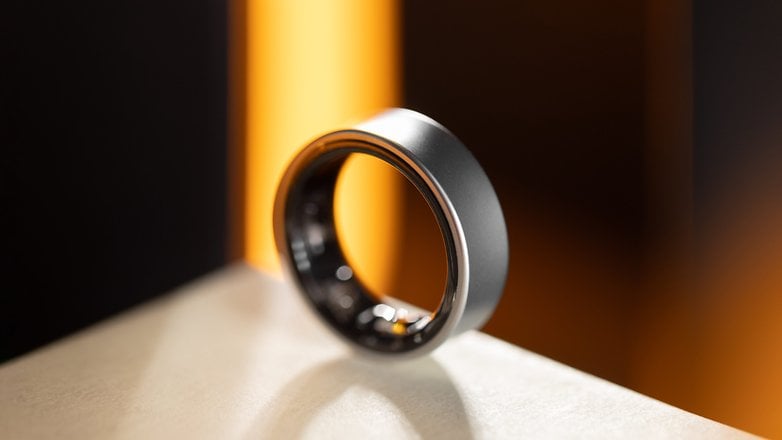
Inside, the Galaxy Ring packs three key sensors: An accelerometer, a Photoplethysmography (PPG) sensor to track blood circulation and oxygen levels, and a skin temperature sensor. For the best accuracy, these need to sit right under your index finger.
Samsung's got you covered on fit too, offering the ring in nine sizes (5 to 13), and you can even grab a sizing kit beforehand—a smart move for getting the perfect fit and optimal experience.
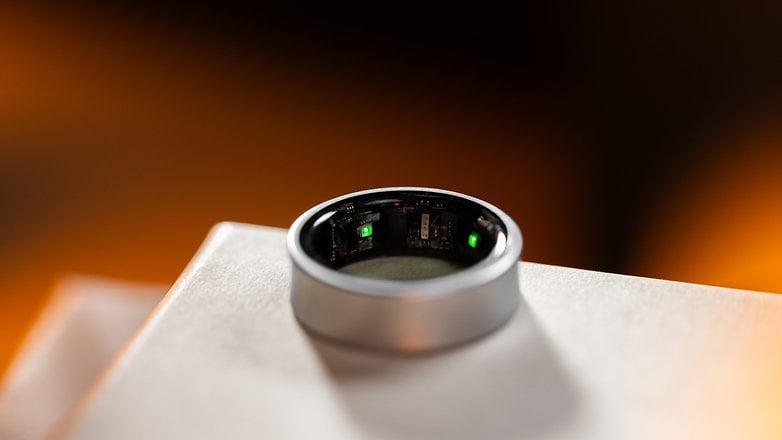
When the Galaxy Ring fits just right, it’s so low-key you might actually forget you’re wearing it—until the data starts rolling in. But, compared to your everyday jewelry, it's definitely a bit chunkier. That extra thickness is the price you pay for all the advanced tech packed inside.
Software & Compatibility
The Galaxy Ring is compatible with Samsung and other Android devices, though there are some expected limitations. You’ll need the Galaxy Wearable app to manage the Ring, and all your health and fitness data will sync through the Galaxy Health app .
Pros:
- Clean and intuitive UI/UX.
- Find My Ring feature on board within the Galaxy ecosystem.
- Samsung adheres to key data privacy regulations in the US and Europe.
Cons:
- A somewhat infantilized UI.
- Requires a smartphone connection due to lack of display.
- Some features are limited with non-Galaxy devices.
- Uncertain how it will integrate multiple health devices in the Wear app.
In my review of the Galaxy Watch Ultra, I briefly touched on how the Samsung Health app’s user interface feels a bit too childish for my liking, and I want to bring it up again. I believe there’s a cultural element at play here—South Korean design often incorporates cute animal icons and little hearts, which doesn’t quite resonate with a Western audience like myself.
I’m also not a fan of the judgmental face on the energy score element. It feels misleading because there are times when our bodies need recovery, and that shouldn’t be viewed as a negative.
That said, the user experience with Samsung Health is quite clean and intuitive, offering some data-driven analysis—which I appreciate. It’s insightful and can spark meaningful conversations around topics like sleep quality, resting heart rate, and recovery. The graphics are well-designed, and there’s a good level of granularity in the daily data we generate, making it both informative and engaging.
Samsung has rolled out a handy feature called Find My Ring, designed to help users locate the smart ring within the Galaxy ecosystem. But there’s a catch: Since the ring only emits light—no sound—finding it in, say, a pile of clothes can be a bit of a struggle. It’s useful, but not exactly foolproof when it comes to everyday clutter.
The Galaxy Ring also comes with two interactive features using its universal gestures function. By double-pinching your index finger and thumb, you can either silence an alarm or snap a picture. It's a subtle, seamless way to control key functions, keeping the experience intuitive and hands-free.
When it comes to health data privacy, the Galaxy Ring follows the same protocols as the Samsung Galaxy Watch and Health app. It adheres to key regulations like the FTC Act and HIPAA in the U.S., as well as GDPR in Europe. While not subject to stringent FDA oversight due to its classification as a wellness device, Samsung still ensures compliance with these critical data privacy standards.
- Stay healthy, stay secure: Protecting your health data for a safer tomorrow
Finally, integrating multiple health devices into the Samsung Health app can be frustrating. According to Samsung, data from both devices is automatically synced in the app, but managing it is difficult because the app doesn’t clearly show which device the data is coming from. At times, I couldn’t tell if the data was from the Ring or the Watch Ultra. It’s like the Holy Spirit—you don’t see it, but you have to trust it’s there.
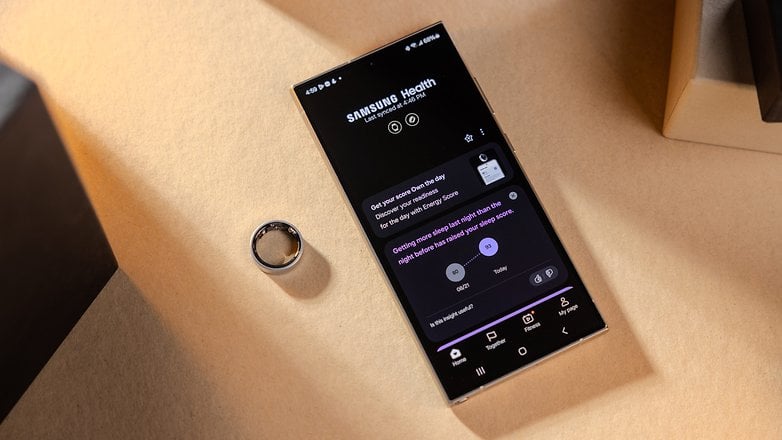
If you're thinking about pairing the Galaxy Ring with the Galaxy Watch Ultra or another Galaxy smartwatch, the idea is pretty straightforward: some sensors on either device could be disabled to save battery, giving you longer life on one or the other. That's a big plus for those wanting to get the most out of both devices.
Another perk? You can gather sleep data without needing to wear a bulky smartwatch to bed, while still having a dedicated display for workouts. In the end, it's a slick—though pricey—synergy for tracking your health and fitness.
Wellness & Fitness Features
Thanks to their form factor, smart rings are the ideal health companion. No distracting display or notification alerts pulling your attention away. Even with just a basic set of sensors, you don’t have to keep your phone on you to ensure your data is safe. Plus, it offers better battery life than most smartwatches and smartphones, so you won’t need to worry about charging it daily .
When it comes to health tracking, the Galaxy Ring proves to be pretty reliable for heart rate monitoring, and after the latest update, its sleep metrics are almost on par with my reference device, the Apple Watch Series 9 (review). That said, while some fitness features and workout modes perform decently, the ring's form factor is undeniably a limiting factor.
Pros:
- Advanced sleep monitoring, cycle tracking, and auto workout detection.
- Energy Score provides a daily overview of mental and physical condition.
- Includes sensors for continuous heart rate monitoring and skin temperature tracking.
Cons:
- Data reliability is heavily dependent on software updates.
- Not really designed with fitness tracking in mind.
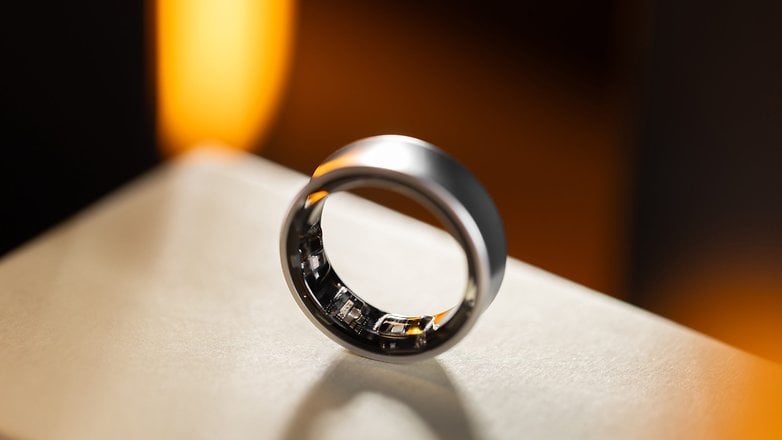
The Galaxy Ring integrates seamlessly with the Health app, bringing familiar features like advanced sleep monitoring, cycle tracking, and auto workout detection for activities like walking and running. Like the latest Galaxy Watch Ultra and Watch 7, it also offers the Energy Score—a daily snapshot of your mental and physical state.
The Energy Score pulls from metrics like sleep duration, previous day's activities, average heart rate, and heart rate variability. While I’ve always valued my Whoop's Daily Overview, Samsung still has room to improve how this data is presented in the Health app.
The Energy Score is meant to tell you how ready you are to tackle the day, and it’s surprisingly realistic. On days when I barely moved, it flagged my low activity, and it did the same when I had poor sleep or pushed past my strain target. What really stood out was seeing how it tracked changes related to my menstrual cycle, though making those connections definitely requires a good understanding of your body.
In my reviews, I like to zero in on specific features to give you a more relatable, hands-on perspective. For the Galaxy Ring, I’ll be taking a closer look at its sleep tracking and running analysis. But before we get into that, there’s something I need to call out: this device really needed a major update to prove itself credible.
Just a few days ago, I was ready to write off the Galaxy Ring. The sleep tracking was all over the place, and the heart rate readings were consistently higher than what I was getting from my trusted devices. A quick search showed I wasn’t alone in this frustration. But then, on Tuesday, September 10, Samsung dropped an update for the Galaxy S24 Ultra, which also optimized the health app.
And here’s the thing: Since that phone (and the Wearable app) update, my heart rate readings have been in sync with my chest strap, and the sleep data has gotten a lot closer to what I see on my Apple Watch Series 9—which is known for being pretty spot-on with sleep stages.
So, while this update was a welcome fix, it’s worth noting that the accuracy of Samsung Health is still highly dependent on regular software updates. That’s something you’ll want to keep in mind.
Sleep Metrics
Let’s be real—sleep analysis is one of the toughest things for a smart device to nail, especially when it’s not a dedicated medical tool. But some of the algorithms powering the health app are getting pretty good at combining heart rate and motion sensor data to better map out your sleep stages.
Devices running the latest One UI 6.1, like the Galaxy S24 Ultra, have actually delivered fairly reliable sleep stage tracking in my experience. Plus, Samsung throws in an AI-powered sleep coach that needs about three weeks of data to generate insights into your sleep habits. It's cool to see what it has to say, but don't expect it to revolutionize your sleep routine. Still, it’s a nice little educational tool.
Your sleep metrics also feed into an overall energy score, so accuracy is key here. If the data’s off, you’ll need to rely on your own body awareness to correct it. That said, the Galaxy Ring has been solid for me, giving readings that align with other devices and my own sense of how rested I feel. If yours isn’t hitting the mark, double-check that both the Ring and companion device have the latest software updates.
Running Stats
For this example, I used a running session after updating One UI, along with the Health and Wear apps. While it’s tricky to run with the Galaxy Ring—since sweat makes the ring slip around—you can still manage. It tends to slide off your index finger, and with no strap to adjust it, there’s not much you can do except ensure it’s positioned correctly, with the notch at the base of your finger.
The Ring can automatically recognize your workout and track metrics like duration, distance, pace, heart rate, cadence, and steps. However, since it lacks built-in GPS, you’ll need to carry your smartphone to track maps and routes. Samsung tracks heart rate across five zones, and that’s pretty much all you’ll get.
In my opinion, the Galaxy Ring isn’t really designed for fitness tracking; it's more suited for step counting and overall wellness monitoring. It’s an interesting addition, but not ideal for fitness enthusiasts. That said, it delivered results close to my Wahoo chest strap. If you're using the Samsung Health app, you can also pair a chest strap as an accessory for even more accurate heart rate data—but the Ring's PPG sensor already does a decent job on its own.
Battery Life & Charging
Samsung claims the Galaxy Ring can last up to 7 days on a single charge, but battery life depends on the size of the ring—the bigger the ring, the more battery it holds. Since I’m using a size 8, one of the smaller versions, I averaged about 5 days, which is decent, but not quite on par with the 8 days I got from the RingConn Gen 2 during my testing .
Pros:
- Up to 7 days of battery life—depending on the ring size.
- Travel Case Charger allows charging anywhere, similar to earbuds.
- Travel case features an LED ring to display the remaining energy level.
Cons:
- -
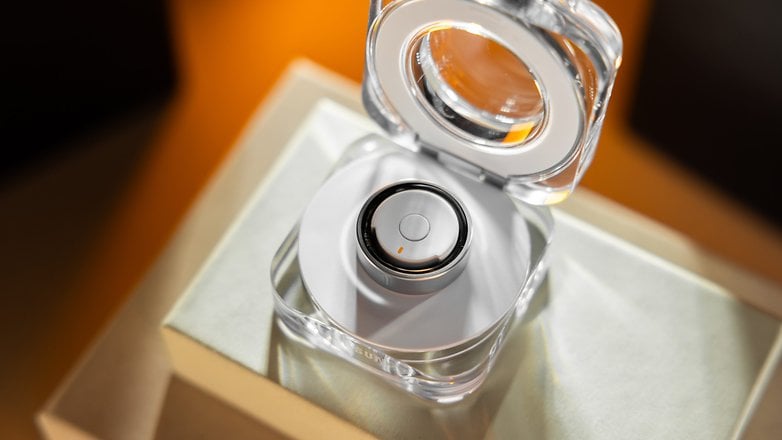
The Galaxy Ring takes about 65 minutes to fully charge, but what really stands out is Samsung’s inclusion of a travel case charger. Just like with earbuds, you can charge the ring on the go without worrying about proper alignment. In just 30 minutes of charging, you can get the battery up to 50%, which is enough to last you almost three days.
The case holds enough juice for up to six full charges, meaning you won’t need to recharge the case for over a month. When you do, it’s as simple as plugging in a USB-C cable.
Plus, there’s a button on the case that lights up an LED ring, showing the remaining power. The transparent design is sleek and functional—definitely a nice touch.
Technical Specifications
| Galaxy Ring | |
|---|---|
| Product | Galaxy Ring |
| Image | 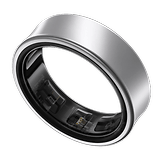 |
| Dimensions and Weight | 7.0 × 2.6 mm, 2,3 g (Size 5) until 3,0 g (Size 13) Charging case: 48.9 × 48.9 × 24.5 mm, 61,3 g |
| Colors | Titanium Black, Titanium Silver, Titanium Gold |
| Sizes | Nine (Sizes: US 5, US 6, US 7, US 8, US 9, US 10, US 11, US 12, US 13) |
| Sensors | Acceleration sensor Optical heart rate sensor Infrared temperature sensor |
| Connectivity | Bluetooth 5.4 |
| Certifications | 10 ATM4, IP68 / Titan-Finish |
| Battery | 18 mAh (US 5, US 6, US 7) 19,5 mAh (US 8, US 9, US 10, US 11) 23,5 mAh (US 12, US 13) Charging case: 361 mAh |
| Software versions | Samsung Galaxy S24 Ultra: One UI 6.1 Samsung Health app: 6.27.2.009 Wearable app: Q50XWWU2AXFI |
Final verdict
After spending some time with the Galaxy Ring, I’ve decided to base my rating primarily on its integration with the Health app and the data I’ve gathered over the past few days. The takeaway? The Galaxy Ring is a solid health tracker, but only when the software is up to speed.
Remember when the Galaxy Watch Ultra launched with battery life issues, and Samsung had to fix it with a software update? Well, my trust in the Galaxy Ring's data felt similar—it got better with an update down the road.
As I mentioned at the start, plenty of reviews call out the Galaxy Ring for its accuracy and reliability—and honestly, they’re not wrong. But there’s a key thing to note: check when those reviews were published. Samsung needed more time to iron out the software kinks in this new wearable, and that’s a big factor in its performance.
Now, let’s talk price: the Galaxy Ring isn’t cheap, especially if you’re pairing it with a smartwatch. But its strength lies in how comfortable and unobtrusive it is. If you’re after something that offers basic health metrics and essentially disappears on your hand, the Galaxy Ring is a great pick. And if you’re already deep in the Galaxy ecosystem, even better. Over time, as it gathers more data, I think anyone even remotely health-conscious will find a lot of value in what it offers.
That said, this device isn’t for fitness enthusiasts—and let’s be real, it’s going to take a while before it is. That’s not a flaw in the Galaxy Ring itself, but more a limitation of the form factor.
So, now the question is: Would you buy the Samsung Galaxy Ring? Drop your thoughts and questions in the comments below!
- Not sold on the Galaxy Ring? Check out our smart rings buying guide for some alternative options that might suit your needs (and your wallet) better.
